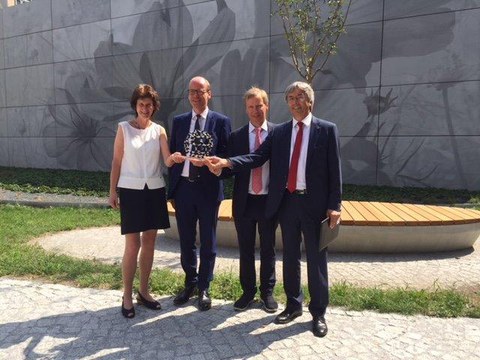Cutting-edge spaces for top-notch research

Finance Minister Dr. Matthias Haß (2nd from left) and Science Minister Dr. Eva-Maria Stange (left), present the key to the Rector of TU Dresden, Prof. Hans Müller-Steinhagen (right) and Prof. Gerhard Fettweis, cfaed Spokesperson (2nd from right).
Grand opening of the new building for the Center for Advancing Electronics Dresden (cfaed)
Author: Matthias Hahndorf
August 17 was a big day for the cfaed Cluster of Excellence. After around three years of construction, the scientists can now take ownership of their new building. Finance Minister Dr. Matthias Haß and Science Minister Dr. Eva-Maria Stange presented the key to the Rector of TU Dresden, Prof. Hans Müller-Steinhagen.
With the opening of the new building, the cluster can bring together a majority of its members at one location for the first time. Laboratories, conference rooms and technical spaces fill around 5,000 m² of space. 324 people will work and conduct research in these rooms.
The Rector is delighted, “Our cfaed Cluster of Excellence has its own building – that means cutting-edge spaces for top-notch research. The cfaed scientists have been researching ground-breaking electronics for years. And I am delighted that the structural conditions for this internationally leading research have been created.”
Prof. Gerhard Fettweis, Spokesperson for the cfaed, is equally thrilled, “This new Barkhausen building is an inspiration to us! The short distances between the individual groups and labs in the new building make the interdisciplinary work we have always wanted possible: electrical engineers can consult with physicists and computer scientists can converse with chemists in the hallways and labs.” All of the speakers also recalled the particular difficulties born by the staff who had to pursue their research in the building during construction and thanked them for their patience.
The technological heart of the project, and most challenging part in terms of construction, was the laboratories for the Dresden Center for Nanoanalysis (DCN). The operation of the high-precision devices requires extremely low-vibration and specially shielded, current-free, temperature-controlled rooms. It was possible to create infrastructure at the cutting edge of modern technology, which will make it possible to support the research of the cfaed with the availability of the newest nanoanalytical methods. The DCN, however, is not only a technology platform for the cfaed, but plans also call for it to be established as an internationally recognized, open user center for nanoanalysis.
This article was published in the Dresdner Universitätsjournal 13/2018 on September 4, 2018. You can download the whole newspaper as a PDF file for free here. Please contact doreen.liesch@tu-dresden.de to order the Universitätsjournal as a printed newpaper or as a PDF file. For more information, please visit: universitaetsjournal.de.
